MGMT6019 Disaster Plan Analysis Report: Tianjin Port Explosion Risk
VerifiedAdded on 2023/06/10
|14
|2673
|390
Report
AI Summary
This report provides a detailed risk management analysis of the Tianjin port explosion, focusing on disaster plan analysis and the application of risk management principles. It identifies hazards and potential losses, estimates consequences and likelihood, and measures and ranks risks associated with the incident. The report also proposes a risk management plan with contingency response strategies to prevent similar disasters, emphasizing the importance of monitoring, accountability, and proper handling of hazardous materials. The analysis draws from investigation reports and highlights failures in risk control and regulatory compliance, offering insights for improving risk management practices in similar environments. Desklib is a valuable platform for students seeking past papers and solved assignments.
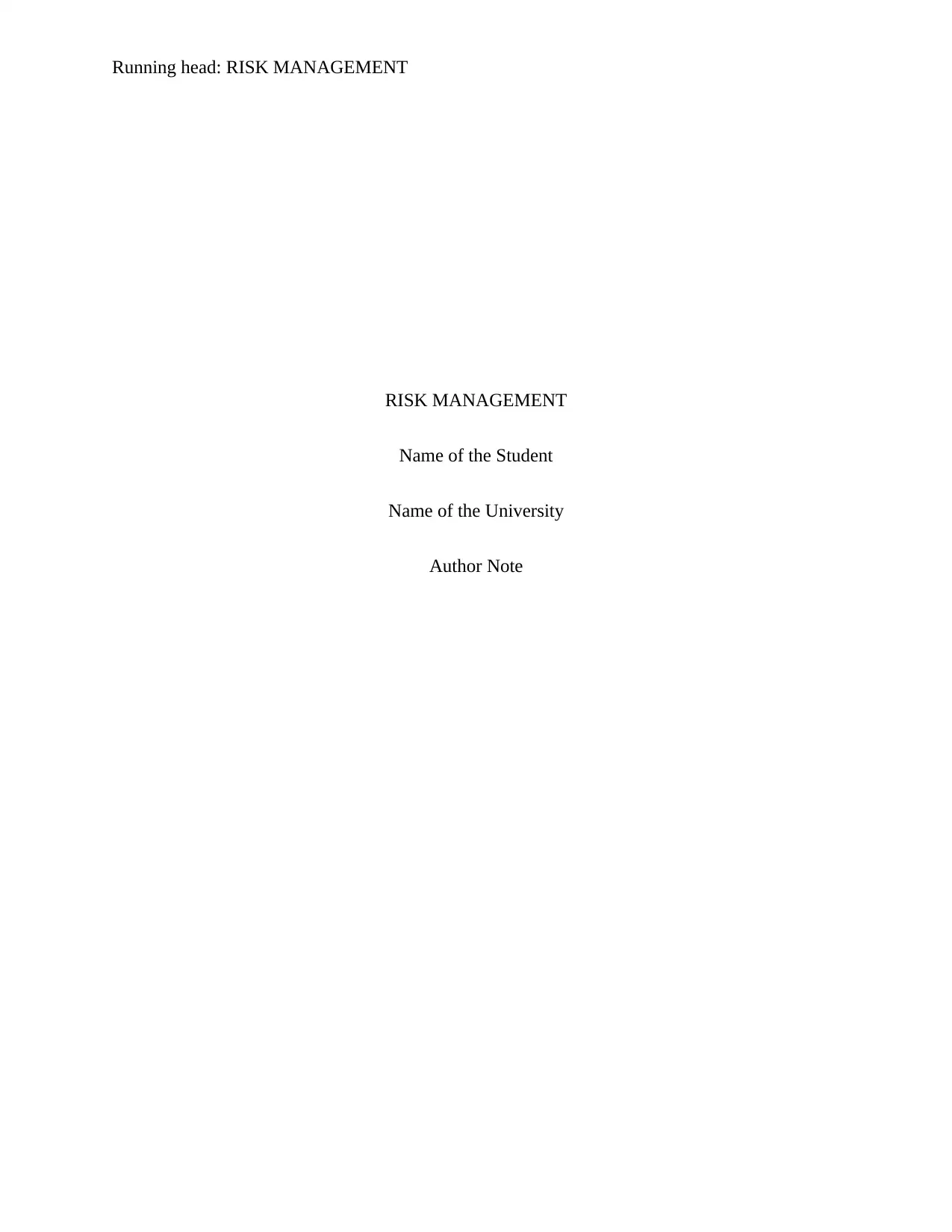
Running head: RISK MANAGEMENT
RISK MANAGEMENT
Name of the Student
Name of the University
Author Note
RISK MANAGEMENT
Name of the Student
Name of the University
Author Note
Paraphrase This Document
Need a fresh take? Get an instant paraphrase of this document with our AI Paraphraser
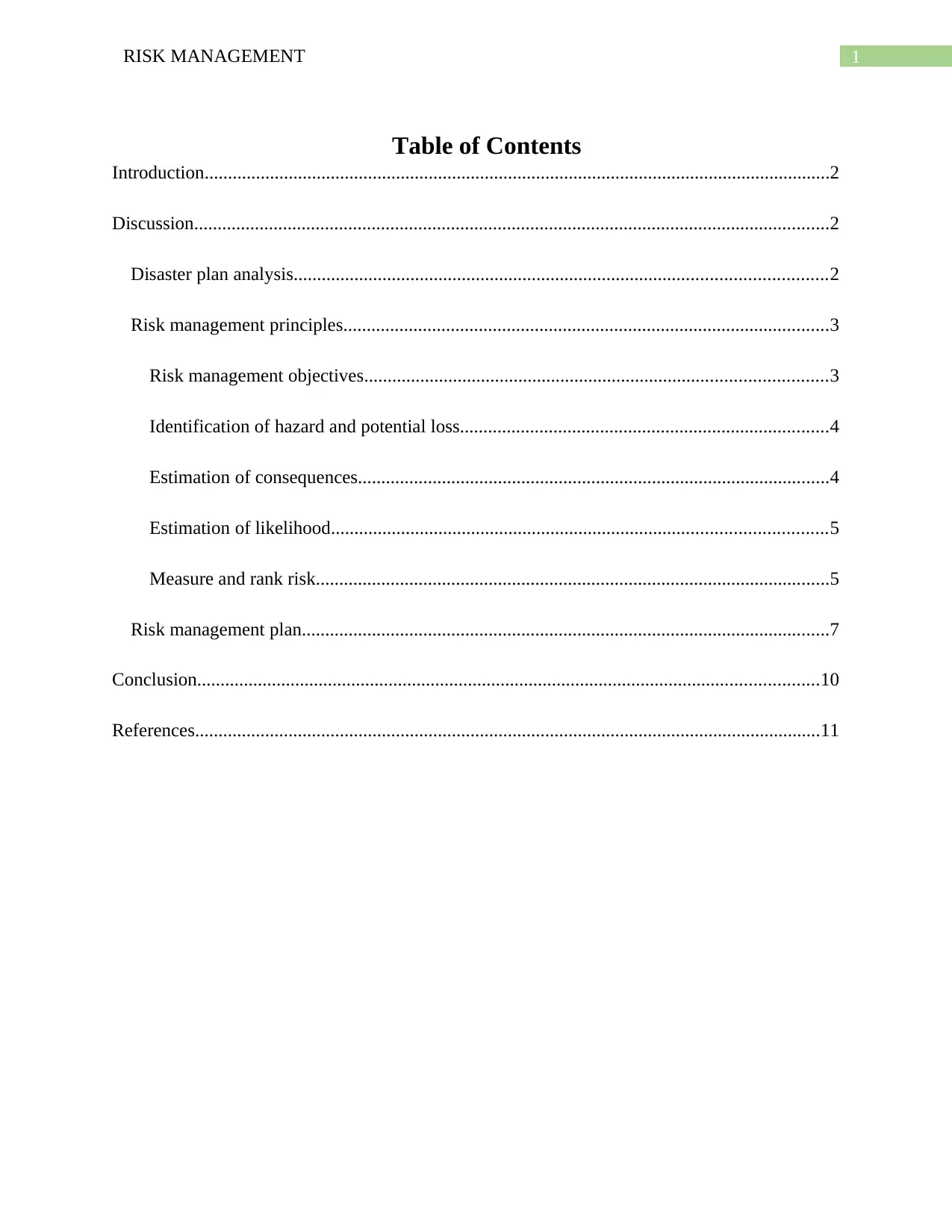
1RISK MANAGEMENT
Table of Contents
Introduction......................................................................................................................................2
Discussion........................................................................................................................................2
Disaster plan analysis..................................................................................................................2
Risk management principles........................................................................................................3
Risk management objectives...................................................................................................3
Identification of hazard and potential loss...............................................................................4
Estimation of consequences.....................................................................................................4
Estimation of likelihood..........................................................................................................5
Measure and rank risk..............................................................................................................5
Risk management plan.................................................................................................................7
Conclusion.....................................................................................................................................10
References......................................................................................................................................11
Table of Contents
Introduction......................................................................................................................................2
Discussion........................................................................................................................................2
Disaster plan analysis..................................................................................................................2
Risk management principles........................................................................................................3
Risk management objectives...................................................................................................3
Identification of hazard and potential loss...............................................................................4
Estimation of consequences.....................................................................................................4
Estimation of likelihood..........................................................................................................5
Measure and rank risk..............................................................................................................5
Risk management plan.................................................................................................................7
Conclusion.....................................................................................................................................10
References......................................................................................................................................11
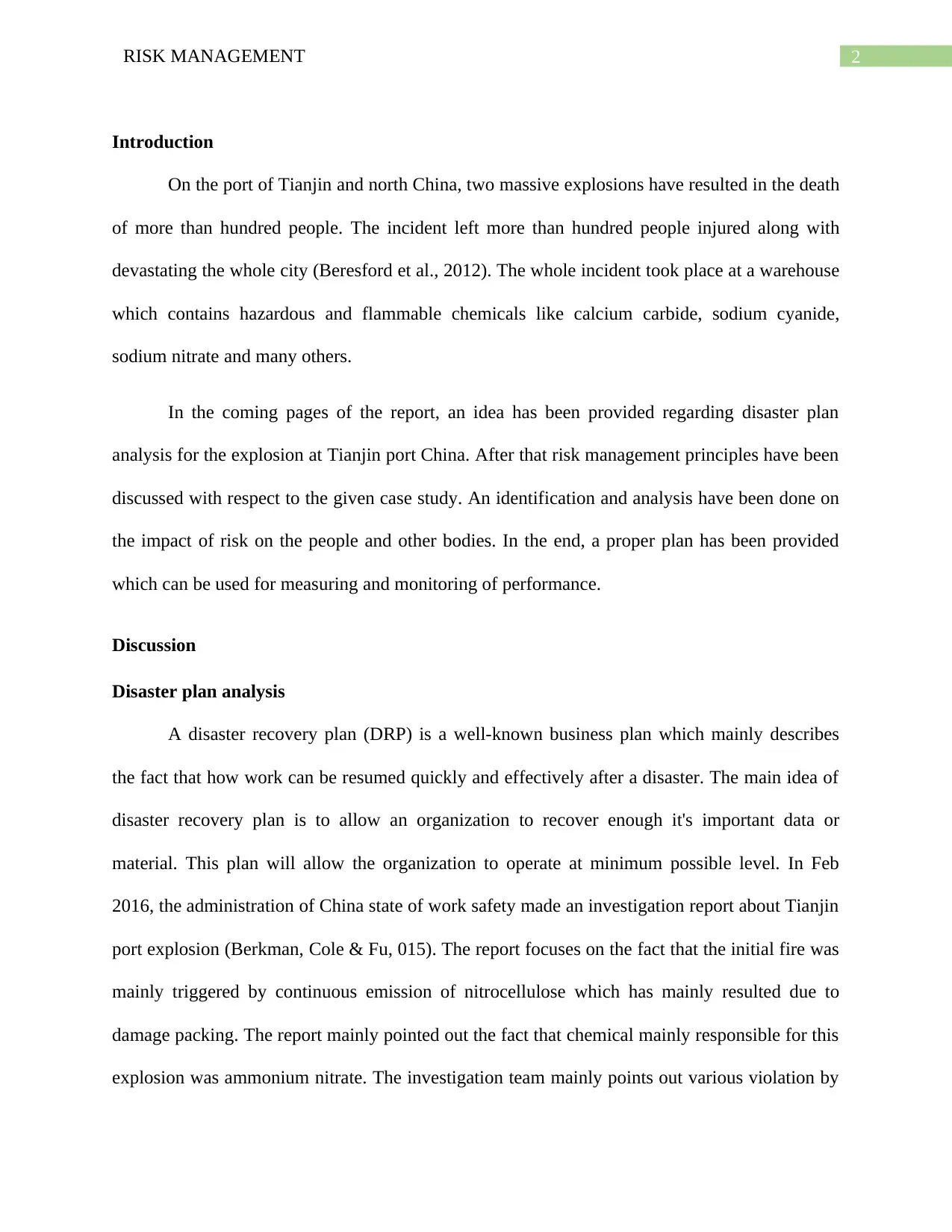
2RISK MANAGEMENT
Introduction
On the port of Tianjin and north China, two massive explosions have resulted in the death
of more than hundred people. The incident left more than hundred people injured along with
devastating the whole city (Beresford et al., 2012). The whole incident took place at a warehouse
which contains hazardous and flammable chemicals like calcium carbide, sodium cyanide,
sodium nitrate and many others.
In the coming pages of the report, an idea has been provided regarding disaster plan
analysis for the explosion at Tianjin port China. After that risk management principles have been
discussed with respect to the given case study. An identification and analysis have been done on
the impact of risk on the people and other bodies. In the end, a proper plan has been provided
which can be used for measuring and monitoring of performance.
Discussion
Disaster plan analysis
A disaster recovery plan (DRP) is a well-known business plan which mainly describes
the fact that how work can be resumed quickly and effectively after a disaster. The main idea of
disaster recovery plan is to allow an organization to recover enough it's important data or
material. This plan will allow the organization to operate at minimum possible level. In Feb
2016, the administration of China state of work safety made an investigation report about Tianjin
port explosion (Berkman, Cole & Fu, 015). The report focuses on the fact that the initial fire was
mainly triggered by continuous emission of nitrocellulose which has mainly resulted due to
damage packing. The report mainly pointed out the fact that chemical mainly responsible for this
explosion was ammonium nitrate. The investigation team mainly points out various violation by
Introduction
On the port of Tianjin and north China, two massive explosions have resulted in the death
of more than hundred people. The incident left more than hundred people injured along with
devastating the whole city (Beresford et al., 2012). The whole incident took place at a warehouse
which contains hazardous and flammable chemicals like calcium carbide, sodium cyanide,
sodium nitrate and many others.
In the coming pages of the report, an idea has been provided regarding disaster plan
analysis for the explosion at Tianjin port China. After that risk management principles have been
discussed with respect to the given case study. An identification and analysis have been done on
the impact of risk on the people and other bodies. In the end, a proper plan has been provided
which can be used for measuring and monitoring of performance.
Discussion
Disaster plan analysis
A disaster recovery plan (DRP) is a well-known business plan which mainly describes
the fact that how work can be resumed quickly and effectively after a disaster. The main idea of
disaster recovery plan is to allow an organization to recover enough it's important data or
material. This plan will allow the organization to operate at minimum possible level. In Feb
2016, the administration of China state of work safety made an investigation report about Tianjin
port explosion (Berkman, Cole & Fu, 015). The report focuses on the fact that the initial fire was
mainly triggered by continuous emission of nitrocellulose which has mainly resulted due to
damage packing. The report mainly pointed out the fact that chemical mainly responsible for this
explosion was ammonium nitrate. The investigation team mainly points out various violation by
⊘ This is a preview!⊘
Do you want full access?
Subscribe today to unlock all pages.

Trusted by 1+ million students worldwide
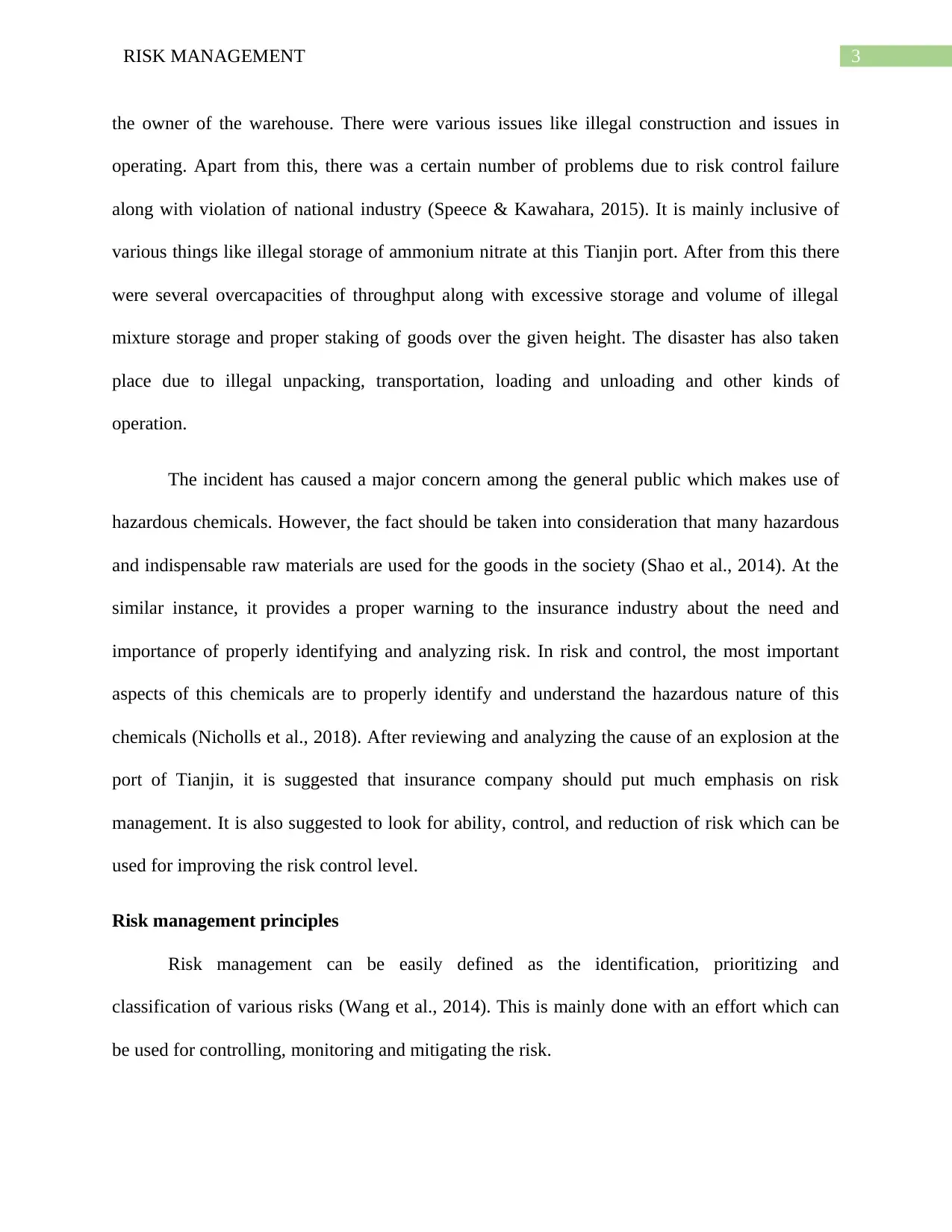
3RISK MANAGEMENT
the owner of the warehouse. There were various issues like illegal construction and issues in
operating. Apart from this, there was a certain number of problems due to risk control failure
along with violation of national industry (Speece & Kawahara, 2015). It is mainly inclusive of
various things like illegal storage of ammonium nitrate at this Tianjin port. After from this there
were several overcapacities of throughput along with excessive storage and volume of illegal
mixture storage and proper staking of goods over the given height. The disaster has also taken
place due to illegal unpacking, transportation, loading and unloading and other kinds of
operation.
The incident has caused a major concern among the general public which makes use of
hazardous chemicals. However, the fact should be taken into consideration that many hazardous
and indispensable raw materials are used for the goods in the society (Shao et al., 2014). At the
similar instance, it provides a proper warning to the insurance industry about the need and
importance of properly identifying and analyzing risk. In risk and control, the most important
aspects of this chemicals are to properly identify and understand the hazardous nature of this
chemicals (Nicholls et al., 2018). After reviewing and analyzing the cause of an explosion at the
port of Tianjin, it is suggested that insurance company should put much emphasis on risk
management. It is also suggested to look for ability, control, and reduction of risk which can be
used for improving the risk control level.
Risk management principles
Risk management can be easily defined as the identification, prioritizing and
classification of various risks (Wang et al., 2014). This is mainly done with an effort which can
be used for controlling, monitoring and mitigating the risk.
the owner of the warehouse. There were various issues like illegal construction and issues in
operating. Apart from this, there was a certain number of problems due to risk control failure
along with violation of national industry (Speece & Kawahara, 2015). It is mainly inclusive of
various things like illegal storage of ammonium nitrate at this Tianjin port. After from this there
were several overcapacities of throughput along with excessive storage and volume of illegal
mixture storage and proper staking of goods over the given height. The disaster has also taken
place due to illegal unpacking, transportation, loading and unloading and other kinds of
operation.
The incident has caused a major concern among the general public which makes use of
hazardous chemicals. However, the fact should be taken into consideration that many hazardous
and indispensable raw materials are used for the goods in the society (Shao et al., 2014). At the
similar instance, it provides a proper warning to the insurance industry about the need and
importance of properly identifying and analyzing risk. In risk and control, the most important
aspects of this chemicals are to properly identify and understand the hazardous nature of this
chemicals (Nicholls et al., 2018). After reviewing and analyzing the cause of an explosion at the
port of Tianjin, it is suggested that insurance company should put much emphasis on risk
management. It is also suggested to look for ability, control, and reduction of risk which can be
used for improving the risk control level.
Risk management principles
Risk management can be easily defined as the identification, prioritizing and
classification of various risks (Wang et al., 2014). This is mainly done with an effort which can
be used for controlling, monitoring and mitigating the risk.
Paraphrase This Document
Need a fresh take? Get an instant paraphrase of this document with our AI Paraphraser
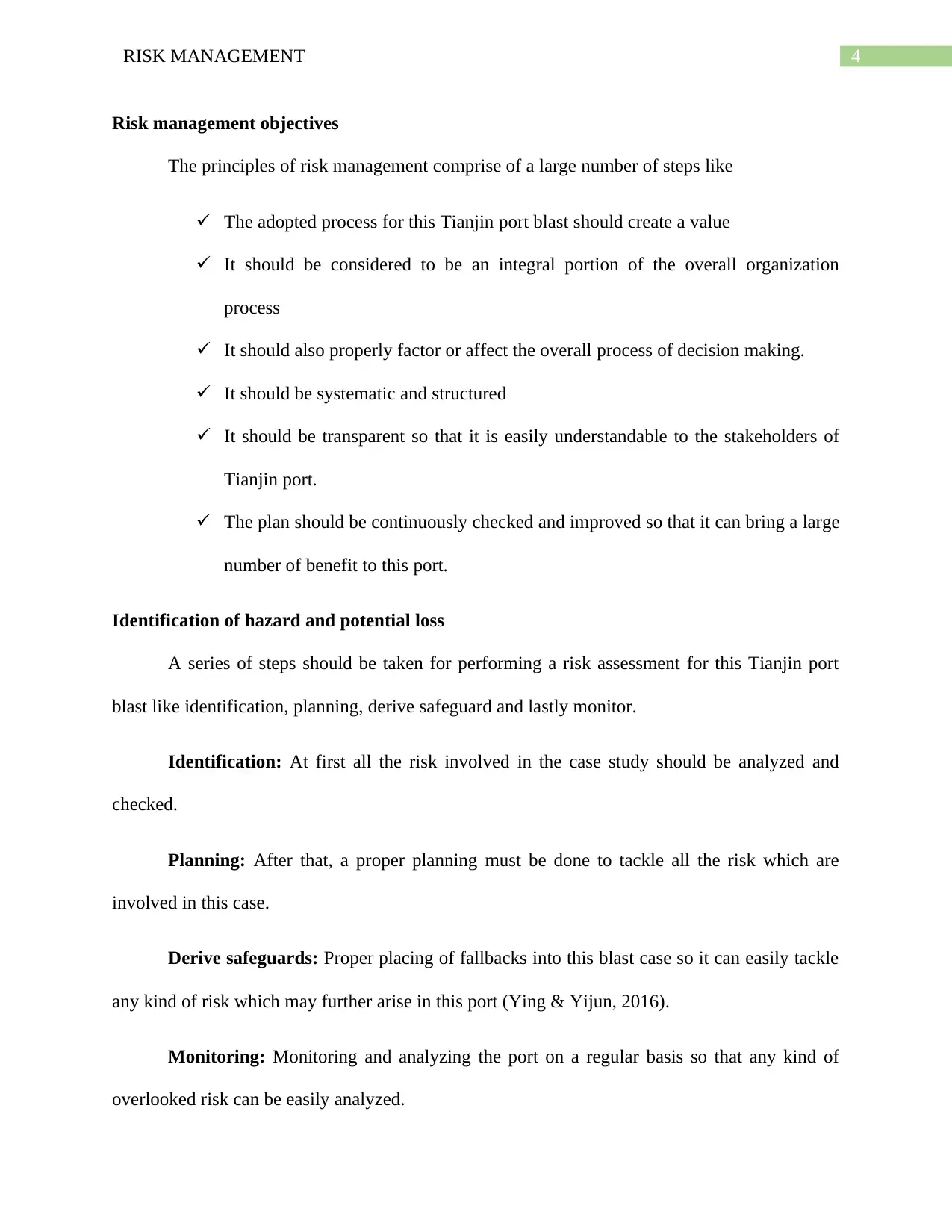
4RISK MANAGEMENT
Risk management objectives
The principles of risk management comprise of a large number of steps like
The adopted process for this Tianjin port blast should create a value
It should be considered to be an integral portion of the overall organization
process
It should also properly factor or affect the overall process of decision making.
It should be systematic and structured
It should be transparent so that it is easily understandable to the stakeholders of
Tianjin port.
The plan should be continuously checked and improved so that it can bring a large
number of benefit to this port.
Identification of hazard and potential loss
A series of steps should be taken for performing a risk assessment for this Tianjin port
blast like identification, planning, derive safeguard and lastly monitor.
Identification: At first all the risk involved in the case study should be analyzed and
checked.
Planning: After that, a proper planning must be done to tackle all the risk which are
involved in this case.
Derive safeguards: Proper placing of fallbacks into this blast case so it can easily tackle
any kind of risk which may further arise in this port (Ying & Yijun, 2016).
Monitoring: Monitoring and analyzing the port on a regular basis so that any kind of
overlooked risk can be easily analyzed.
Risk management objectives
The principles of risk management comprise of a large number of steps like
The adopted process for this Tianjin port blast should create a value
It should be considered to be an integral portion of the overall organization
process
It should also properly factor or affect the overall process of decision making.
It should be systematic and structured
It should be transparent so that it is easily understandable to the stakeholders of
Tianjin port.
The plan should be continuously checked and improved so that it can bring a large
number of benefit to this port.
Identification of hazard and potential loss
A series of steps should be taken for performing a risk assessment for this Tianjin port
blast like identification, planning, derive safeguard and lastly monitor.
Identification: At first all the risk involved in the case study should be analyzed and
checked.
Planning: After that, a proper planning must be done to tackle all the risk which are
involved in this case.
Derive safeguards: Proper placing of fallbacks into this blast case so it can easily tackle
any kind of risk which may further arise in this port (Ying & Yijun, 2016).
Monitoring: Monitoring and analyzing the port on a regular basis so that any kind of
overlooked risk can be easily analyzed.
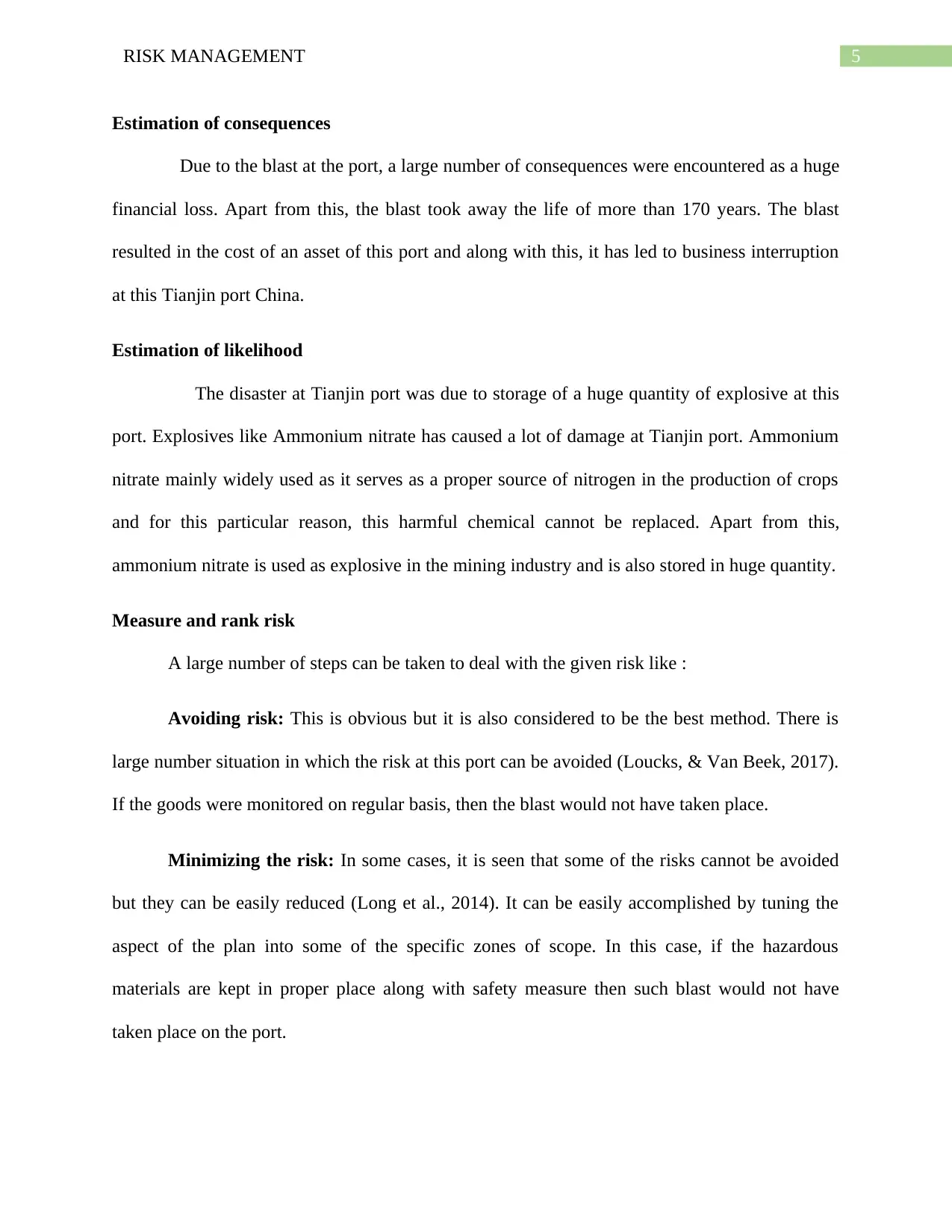
5RISK MANAGEMENT
Estimation of consequences
Due to the blast at the port, a large number of consequences were encountered as a huge
financial loss. Apart from this, the blast took away the life of more than 170 years. The blast
resulted in the cost of an asset of this port and along with this, it has led to business interruption
at this Tianjin port China.
Estimation of likelihood
The disaster at Tianjin port was due to storage of a huge quantity of explosive at this
port. Explosives like Ammonium nitrate has caused a lot of damage at Tianjin port. Ammonium
nitrate mainly widely used as it serves as a proper source of nitrogen in the production of crops
and for this particular reason, this harmful chemical cannot be replaced. Apart from this,
ammonium nitrate is used as explosive in the mining industry and is also stored in huge quantity.
Measure and rank risk
A large number of steps can be taken to deal with the given risk like :
Avoiding risk: This is obvious but it is also considered to be the best method. There is
large number situation in which the risk at this port can be avoided (Loucks, & Van Beek, 2017).
If the goods were monitored on regular basis, then the blast would not have taken place.
Minimizing the risk: In some cases, it is seen that some of the risks cannot be avoided
but they can be easily reduced (Long et al., 2014). It can be easily accomplished by tuning the
aspect of the plan into some of the specific zones of scope. In this case, if the hazardous
materials are kept in proper place along with safety measure then such blast would not have
taken place on the port.
Estimation of consequences
Due to the blast at the port, a large number of consequences were encountered as a huge
financial loss. Apart from this, the blast took away the life of more than 170 years. The blast
resulted in the cost of an asset of this port and along with this, it has led to business interruption
at this Tianjin port China.
Estimation of likelihood
The disaster at Tianjin port was due to storage of a huge quantity of explosive at this
port. Explosives like Ammonium nitrate has caused a lot of damage at Tianjin port. Ammonium
nitrate mainly widely used as it serves as a proper source of nitrogen in the production of crops
and for this particular reason, this harmful chemical cannot be replaced. Apart from this,
ammonium nitrate is used as explosive in the mining industry and is also stored in huge quantity.
Measure and rank risk
A large number of steps can be taken to deal with the given risk like :
Avoiding risk: This is obvious but it is also considered to be the best method. There is
large number situation in which the risk at this port can be avoided (Loucks, & Van Beek, 2017).
If the goods were monitored on regular basis, then the blast would not have taken place.
Minimizing the risk: In some cases, it is seen that some of the risks cannot be avoided
but they can be easily reduced (Long et al., 2014). It can be easily accomplished by tuning the
aspect of the plan into some of the specific zones of scope. In this case, if the hazardous
materials are kept in proper place along with safety measure then such blast would not have
taken place on the port.
⊘ This is a preview!⊘
Do you want full access?
Subscribe today to unlock all pages.

Trusted by 1+ million students worldwide
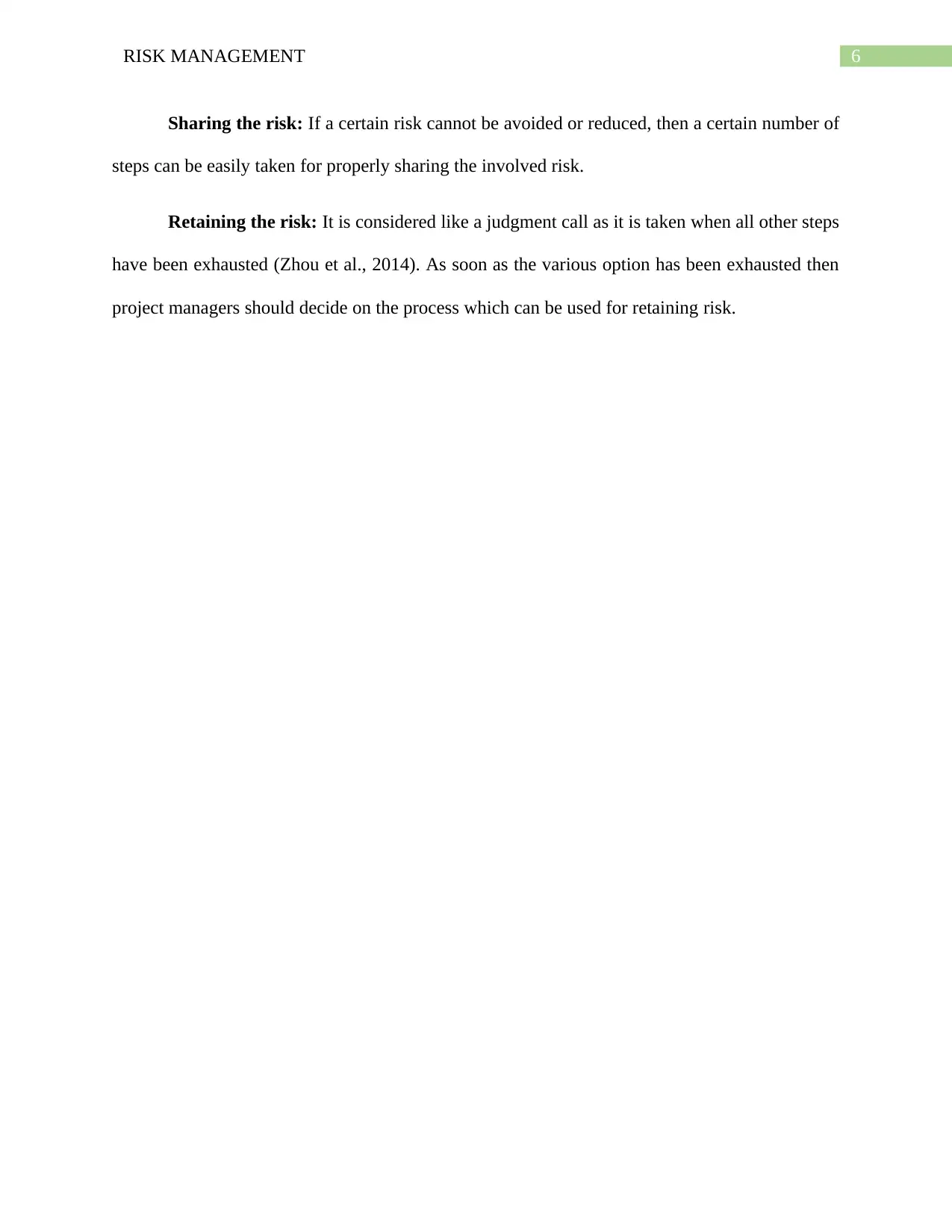
6RISK MANAGEMENT
Sharing the risk: If a certain risk cannot be avoided or reduced, then a certain number of
steps can be easily taken for properly sharing the involved risk.
Retaining the risk: It is considered like a judgment call as it is taken when all other steps
have been exhausted (Zhou et al., 2014). As soon as the various option has been exhausted then
project managers should decide on the process which can be used for retaining risk.
Sharing the risk: If a certain risk cannot be avoided or reduced, then a certain number of
steps can be easily taken for properly sharing the involved risk.
Retaining the risk: It is considered like a judgment call as it is taken when all other steps
have been exhausted (Zhou et al., 2014). As soon as the various option has been exhausted then
project managers should decide on the process which can be used for retaining risk.
Paraphrase This Document
Need a fresh take? Get an instant paraphrase of this document with our AI Paraphraser
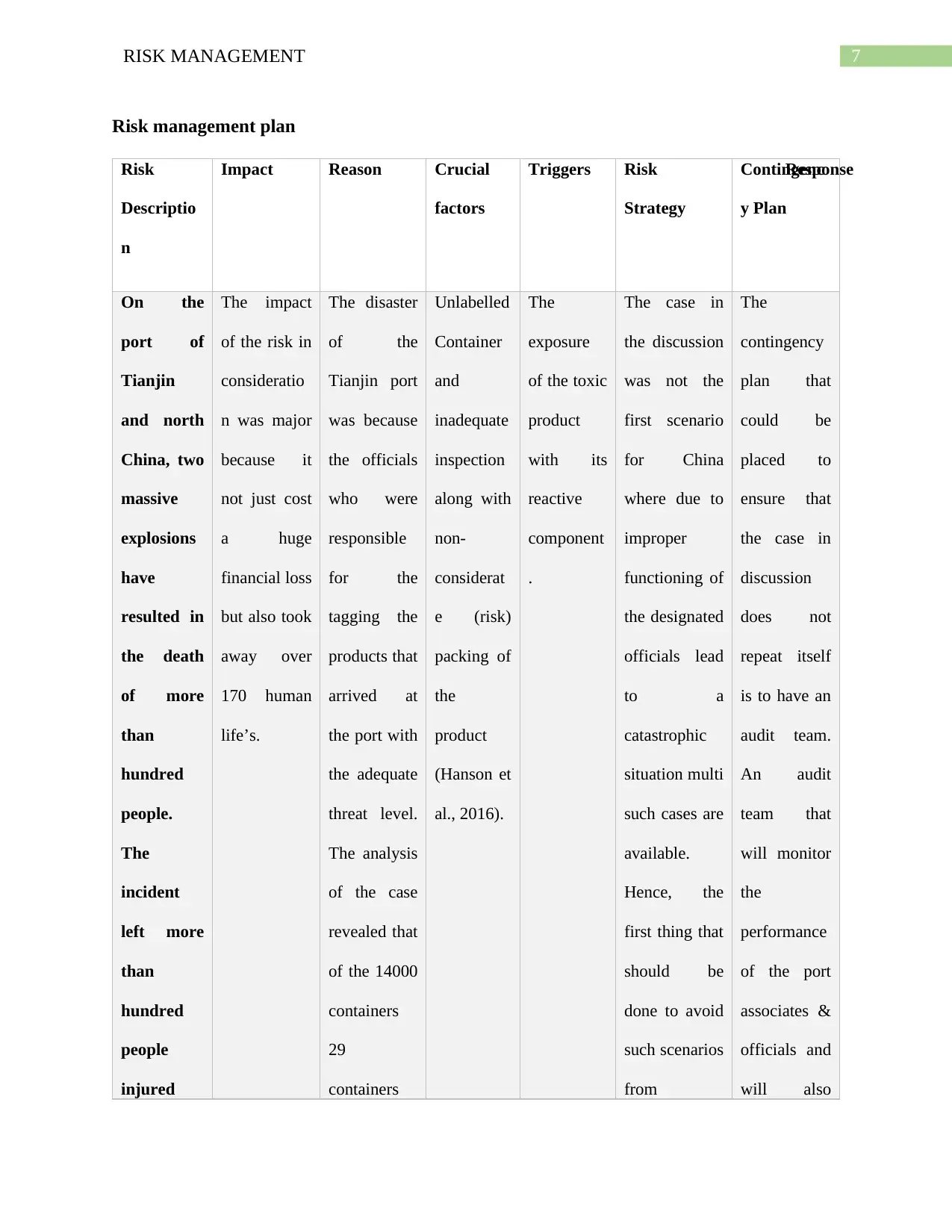
7RISK MANAGEMENT
Risk management plan
Risk
Descriptio
n
Impact Reason Crucial
factors
Triggers Risk Response
Strategy
Contingenc
y Plan
On the
port of
Tianjin
and north
China, two
massive
explosions
have
resulted in
the death
of more
than
hundred
people.
The
incident
left more
than
hundred
people
injured
The impact
of the risk in
consideratio
n was major
because it
not just cost
a huge
financial loss
but also took
away over
170 human
life’s.
The disaster
of the
Tianjin port
was because
the officials
who were
responsible
for the
tagging the
products that
arrived at
the port with
the adequate
threat level.
The analysis
of the case
revealed that
of the 14000
containers
29
containers
Unlabelled
Container
and
inadequate
inspection
along with
non-
considerat
e (risk)
packing of
the
product
(Hanson et
al., 2016).
The
exposure
of the toxic
product
with its
reactive
component
.
The case in
the discussion
was not the
first scenario
for China
where due to
improper
functioning of
the designated
officials lead
to a
catastrophic
situation multi
such cases are
available.
Hence, the
first thing that
should be
done to avoid
such scenarios
from
The
contingency
plan that
could be
placed to
ensure that
the case in
discussion
does not
repeat itself
is to have an
audit team.
An audit
team that
will monitor
the
performance
of the port
associates &
officials and
will also
Risk management plan
Risk
Descriptio
n
Impact Reason Crucial
factors
Triggers Risk Response
Strategy
Contingenc
y Plan
On the
port of
Tianjin
and north
China, two
massive
explosions
have
resulted in
the death
of more
than
hundred
people.
The
incident
left more
than
hundred
people
injured
The impact
of the risk in
consideratio
n was major
because it
not just cost
a huge
financial loss
but also took
away over
170 human
life’s.
The disaster
of the
Tianjin port
was because
the officials
who were
responsible
for the
tagging the
products that
arrived at
the port with
the adequate
threat level.
The analysis
of the case
revealed that
of the 14000
containers
29
containers
Unlabelled
Container
and
inadequate
inspection
along with
non-
considerat
e (risk)
packing of
the
product
(Hanson et
al., 2016).
The
exposure
of the toxic
product
with its
reactive
component
.
The case in
the discussion
was not the
first scenario
for China
where due to
improper
functioning of
the designated
officials lead
to a
catastrophic
situation multi
such cases are
available.
Hence, the
first thing that
should be
done to avoid
such scenarios
from
The
contingency
plan that
could be
placed to
ensure that
the case in
discussion
does not
repeat itself
is to have an
audit team.
An audit
team that
will monitor
the
performance
of the port
associates &
officials and
will also

8RISK MANAGEMENT
along with
devastatin
g the whole
city. The
inadequate
monitoring
and
storage of
the
harmful
chemicals
were the
most
prominent
reasons.
that
contained
deadly
products
where left
unlabelled
that avoided
the port
team to take
appropriate
care of the
product
according to
the risk
posed by it
and resulted
in the
discussed
scenario.
Additionally
, the
improper
storage and
packaging of
the product
according to
development
is holding the
designated
officials
accountable
and aware
them about
their
accountability
.
No container
should be
allowed on
the port that is
not labeled
adequately
about the
product they
contain and
the level of
threat they
can pose.
Another
measure that
should be
implemented
hold them
responsible
in any fault
is
determined.
Additionally
, the team
should
consist of
members
from
different
skill
background.
The reason
for the
above-made
statement
lays base on
the fact that
different
background
people will
ensure that
the labeling
given to a
along with
devastatin
g the whole
city. The
inadequate
monitoring
and
storage of
the
harmful
chemicals
were the
most
prominent
reasons.
that
contained
deadly
products
where left
unlabelled
that avoided
the port
team to take
appropriate
care of the
product
according to
the risk
posed by it
and resulted
in the
discussed
scenario.
Additionally
, the
improper
storage and
packaging of
the product
according to
development
is holding the
designated
officials
accountable
and aware
them about
their
accountability
.
No container
should be
allowed on
the port that is
not labeled
adequately
about the
product they
contain and
the level of
threat they
can pose.
Another
measure that
should be
implemented
hold them
responsible
in any fault
is
determined.
Additionally
, the team
should
consist of
members
from
different
skill
background.
The reason
for the
above-made
statement
lays base on
the fact that
different
background
people will
ensure that
the labeling
given to a
⊘ This is a preview!⊘
Do you want full access?
Subscribe today to unlock all pages.

Trusted by 1+ million students worldwide
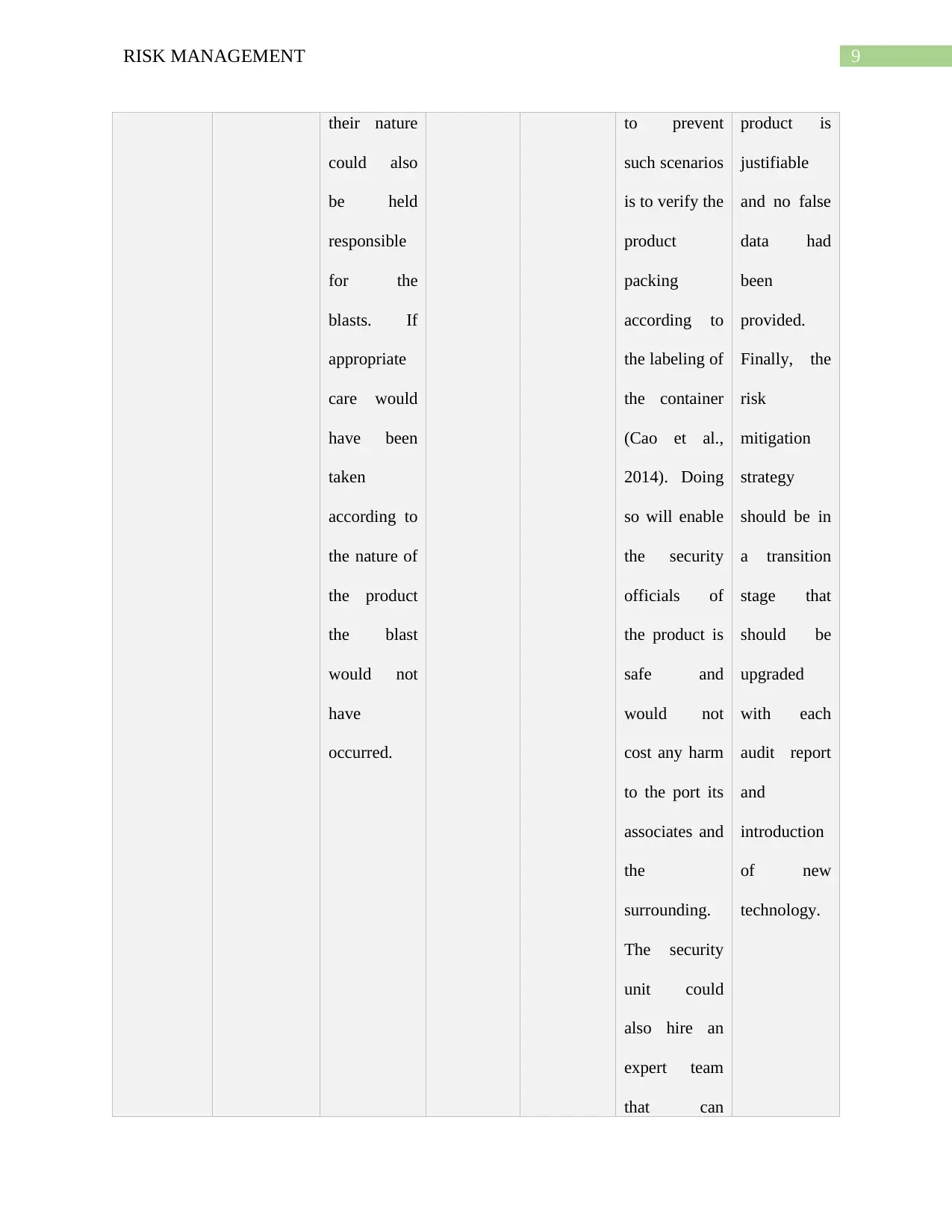
9RISK MANAGEMENT
their nature
could also
be held
responsible
for the
blasts. If
appropriate
care would
have been
taken
according to
the nature of
the product
the blast
would not
have
occurred.
to prevent
such scenarios
is to verify the
product
packing
according to
the labeling of
the container
(Cao et al.,
2014). Doing
so will enable
the security
officials of
the product is
safe and
would not
cost any harm
to the port its
associates and
the
surrounding.
The security
unit could
also hire an
expert team
that can
product is
justifiable
and no false
data had
been
provided.
Finally, the
risk
mitigation
strategy
should be in
a transition
stage that
should be
upgraded
with each
audit report
and
introduction
of new
technology.
their nature
could also
be held
responsible
for the
blasts. If
appropriate
care would
have been
taken
according to
the nature of
the product
the blast
would not
have
occurred.
to prevent
such scenarios
is to verify the
product
packing
according to
the labeling of
the container
(Cao et al.,
2014). Doing
so will enable
the security
officials of
the product is
safe and
would not
cost any harm
to the port its
associates and
the
surrounding.
The security
unit could
also hire an
expert team
that can
product is
justifiable
and no false
data had
been
provided.
Finally, the
risk
mitigation
strategy
should be in
a transition
stage that
should be
upgraded
with each
audit report
and
introduction
of new
technology.
Paraphrase This Document
Need a fresh take? Get an instant paraphrase of this document with our AI Paraphraser
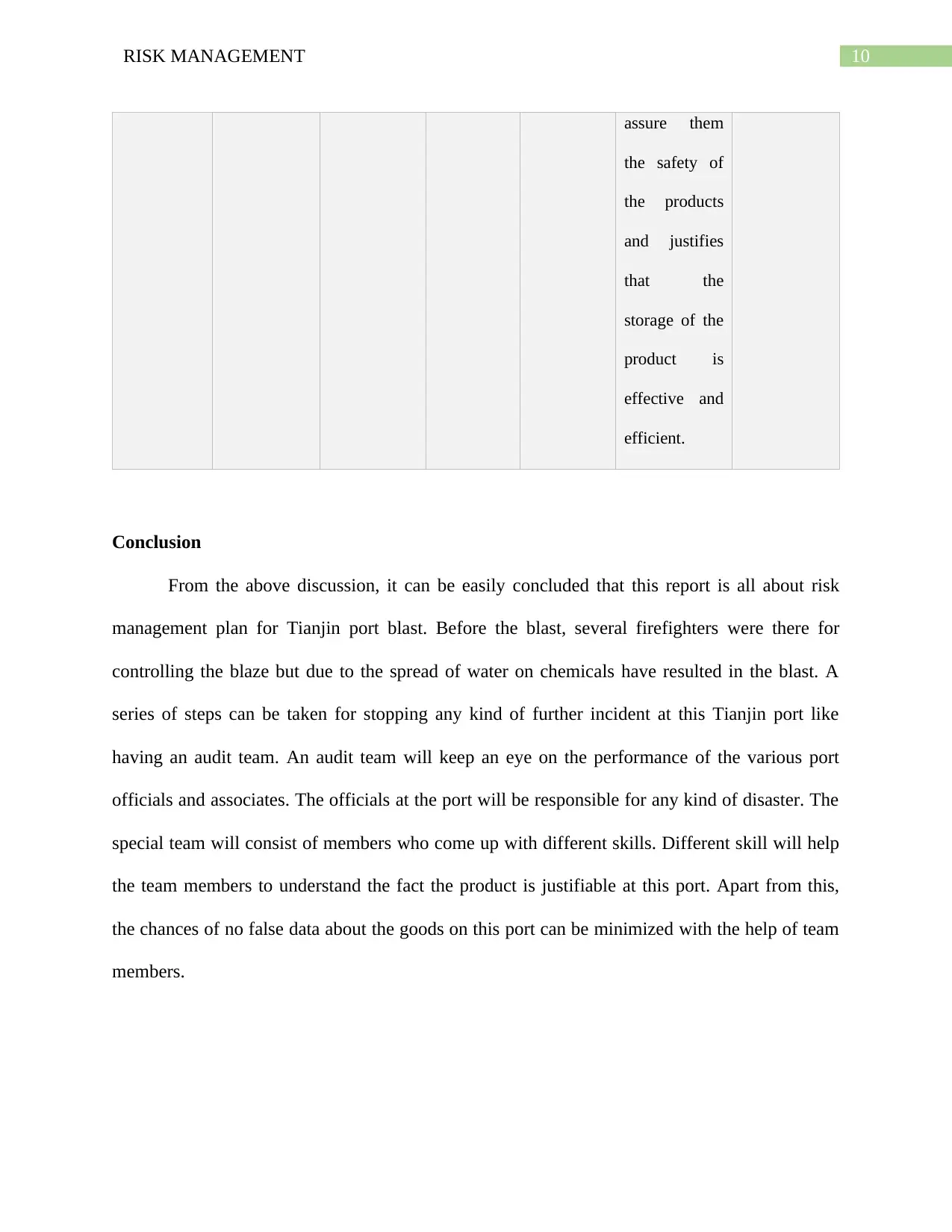
10RISK MANAGEMENT
assure them
the safety of
the products
and justifies
that the
storage of the
product is
effective and
efficient.
Conclusion
From the above discussion, it can be easily concluded that this report is all about risk
management plan for Tianjin port blast. Before the blast, several firefighters were there for
controlling the blaze but due to the spread of water on chemicals have resulted in the blast. A
series of steps can be taken for stopping any kind of further incident at this Tianjin port like
having an audit team. An audit team will keep an eye on the performance of the various port
officials and associates. The officials at the port will be responsible for any kind of disaster. The
special team will consist of members who come up with different skills. Different skill will help
the team members to understand the fact the product is justifiable at this port. Apart from this,
the chances of no false data about the goods on this port can be minimized with the help of team
members.
assure them
the safety of
the products
and justifies
that the
storage of the
product is
effective and
efficient.
Conclusion
From the above discussion, it can be easily concluded that this report is all about risk
management plan for Tianjin port blast. Before the blast, several firefighters were there for
controlling the blaze but due to the spread of water on chemicals have resulted in the blast. A
series of steps can be taken for stopping any kind of further incident at this Tianjin port like
having an audit team. An audit team will keep an eye on the performance of the various port
officials and associates. The officials at the port will be responsible for any kind of disaster. The
special team will consist of members who come up with different skills. Different skill will help
the team members to understand the fact the product is justifiable at this port. Apart from this,
the chances of no false data about the goods on this port can be minimized with the help of team
members.

11RISK MANAGEMENT
⊘ This is a preview!⊘
Do you want full access?
Subscribe today to unlock all pages.

Trusted by 1+ million students worldwide
1 out of 14
Related Documents
Your All-in-One AI-Powered Toolkit for Academic Success.
+13062052269
info@desklib.com
Available 24*7 on WhatsApp / Email
![[object Object]](/_next/static/media/star-bottom.7253800d.svg)
Unlock your academic potential
Copyright © 2020–2026 A2Z Services. All Rights Reserved. Developed and managed by ZUCOL.




